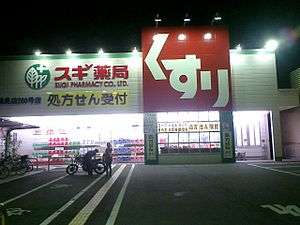Drugstore

Drugstore is a common American term for a type of retail store centrally featuring a pharmacy that dispenses prescription medication and sells over-the-counter medications. Drugstores also sell miscellaneous items such as candy, cosmetics, cleaning supplies, magazines, and paperback books, as well as light refreshments. It is noted that "[s]ome drugstores are pharmacies with a pharmacist on duty, while others primarily sell toiletries".[1]
Drugstores became common in the United States between 1870 and 1920, as an increasing focus on pharmaceutical education led to a shift in medical practices:
During this period pharmacy's part in healthcare solidified, as the dispensing of medicines by physicians declined. However, the rise of the cut-rate drugstore and, more importantly, the chain drugstore, also occurred during these 50 years...
Still, most pharmacists worked in their own corner drugstore, which became a fixture in American life with its shelves of patent medicines for all ills and a soda fountain for delightful beverages; the proprietor, often called doc, attended to the minor aches and pains of customers or made chocolate sodas with equal skill. Although the pharmacist relied on prescription compounding for his professional identity, this provided only a small fraction of his income. Most drugstore owners received more income from sales at the tobacco counter or the soda fountain.[2]
The American drugstore also used to function as a social hub where people could meet for an ice cream soda, as described for example in Ray Bradbury's Dandelion Wine and Tom Reamy's Blind Voices, both set in the 1920s, and sitcom I Love Lucy, set in the 1950s.
The Netherlands
In the Netherlands, there is a distinct difference between a drugstore (drogisterij) and a pharmacy (apotheek).[3] A pharmacy has prescription drugs, while a drugstore does not.[4] Some drugs are OTC only in a pharmacy, others can also be bought at a drugstore, sometimes drugstores have to sell smaller amounts or lower dosages. Only the most harmless of drugs can be sold in general stores like supermarkets and gas stations. Examples of drugs that cannot be sold by general stores but can be sold by a drugstore are naproxen, diclofenac and cinnarizine. A Dutch drugstore, especially when it's a chain store, usually also sells other items like homeopathic products, vitamins, candy, cosmetic products, toys and gadgets.
References
- ↑ Kazuyuki Motohashi, Global Business Strategy: Multinational Corporations (2015), p. 167.
- ↑ Loyd V. Allen, Remington: An Introduction to Pharmacy (2013), p. 22-23.
- ↑ Susanne Bomhard, ed., At Home in Holland (2009), p. 88-89.
- ↑ Margaret Kelly, Carolyn Galgano, Fodor's Amsterdam & the Netherlands: With Side Trips Through Belgium (2011), p. 446.